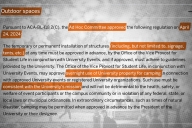You have /5 articles left.
Sign up for a free account or log in.

skynesher/E+/getty images
One topic that will reliably rouse debate among STEM instructors—as well as instructors in many other disciplines—is what materials we should let student bring with them when they take their exams. Reviews of research studies have not come to any definitive solutions. But I’ve conducted my own experiments in the classroom and discovered some insightful results.
In my prealgebra and college algebra courses, I routinely allowed students to have a three-by-five index card with information written on both sides. I then changed that policy to allow one page of notes, one side only, during an exam. I have been long convinced of the benefits of this practice. Recently, however, a peer suggested to me that it was actually causing stress for some of my students as they tried to decide what to include on their note sheets. So, in response, I decided to survey them to see if the reality did not match my intentions and beliefs.
In the 2021–22 academic year, I gave a brief multiple-choice survey to 93 students during the last week of my math classes—including prealgebra, college algebra and a general education course on the math of money. The students ranged from those completing a required course for their STEM major to nonmajors. By this point in the semester, when the late-drop deadline had passed, almost three-quarters of the students (72 percent) were expecting an A or B in the course. Of those who took the survey, 48 were expecting an A, 24 a B and 18 a C. Only three students thought they’d get a D. And, in fact, since I gave the survey in person during the last week of classes, it did tend to favor the population of better students with good class-attendance habits.
What were the specific results of the survey? Below, I’ll briefly summarize the students’ answers to each question.
How many students took advantage of the opportunity to use the note sheet? All of them said they’d used a note sheet for their exams, with 75 percent having used one for every exam. A large majority—around 90 percent—had written enough to cover most of the page, with many saying they used “as much as they could fit on the page and still read it.” Most students, 86 percent, said they included both words or phrases and sample problems on the page. The majority (73 percent) prepared their note sheet as they reviewed for the exam, with about 20 percent writing up their notes on the day of the exam (but thankfully not in the few minutes before the exam—only one of the C-expected students did that).
How often did students refer to their note sheet during an exam? Over all, about half the students looked at it “several times,” while about a third reviewed it just once or twice. Close to 13 percent said they needed to look at it for most problems (the number in that category increased as the expected grade decreased), and 2 percent of those expecting an A never looked at it.
Did having the note sheet to reference mean that the students could answer questions by just copying—without really understanding? That choice had zero responses. About 4 percent of those expecting a B, as well as two of the three students expecting a D, said that the note sheet “did not help when I did not understand anyway.” Over all, the majority (96 percent) said that the note sheet either helped prevent them from “making just a couple of mistakes” or “helped [them] know that they were not making any mistakes” (about equally split).
What effect did the note sheet have on thought processes? Did students feel calmer, more confident or less anxious during the exam? Over all, about half, mostly those expecting A’s and B’s, said that it helped them feel “much more confident and calmer.” About 25 percent said it helped them feel “a little more confident and calmer,” and 23 percent (the largest portion among those who expected a C) said it helped prevent them “from completely going blank with anxiety.”
If given the choice, would students prefer to have the single page of notes, have access to more or have access to less while taking an exam? Three-quarters, or 67 percent, of the students would make the choice to continue to have the same option of preparing a single page of notes to use. Another 28 percent said they would rather have the option to use all their notes during an exam. (The number making that choice increased as the grade decreased.) Only one student, who was expecting a B, preferred not to have access to any notes during an exam. And the small remainder, all expecting A’s, would choose to just use a small notecard with notes during an exam.
From this limited, brief simple survey, it was evident to me that most of my students valued the opportunity to use a single page of notes during an exam and incorporated it with their exam review. During the exam, it functioned as a means of verification and error prevention for most students. The presence of the note sheet did not appear to confer the advantage of being able to complete material that was not already understood. Its availability had a very positive effect on most students’ ability to do their best on the exam, helping them to remain calm and confident and relieving their anxiety. And, given the choice, many more students would opt for having the single page of notes over even having complete access to their notes to use during an exam.
I am satisfied that the results were consistent with my intuition and reasoned decision to provide this option for my students. I have not observed and do not find evidence in the survey for the idea that having the note sheet encourages incompetence with the material. My intention has been to allow a tool that, by organizing and rewriting material as part of their review, helps students make minor corrections in a stressful exam environment. My desire is to also give students a means of preventing the anxiety that can absolutely derail even the best efforts in showing competence. I also believe that the short-term memorization not having a note sheet may require does not result in the long-term retention of key information.
Perhaps less obvious is the role that I’ve found allowing such an exam aid can have on the student-instructor relationship. Letting students bring appropriate notes to an exam is evidence that we have reasonable and realistic expectations, which in turn may garner their respect and thus motivation. One student added the following statement at the end of the survey: “I liked the notes, because we are allowed to use resources in the work field.”
Although my decisions and results only involved my own classes, the general factors in this situation can apply to a wide range of courses. Many faculty members possibly have already adopted similar practices, and I hope the results provide some evidence that your intuition is also valid. In the decision to allow an aid during an exam, realistic parameters about what students must have memorized in their field can be balanced with appropriate tools to encourage an accurate display of knowledge.








